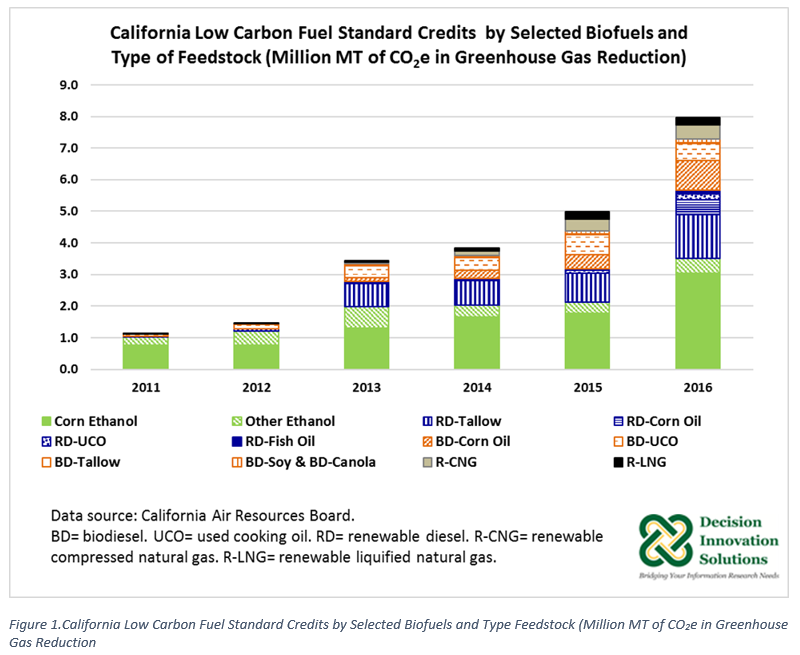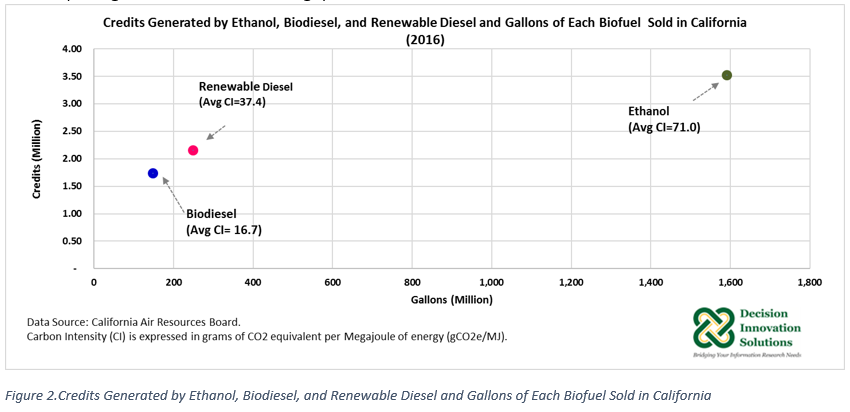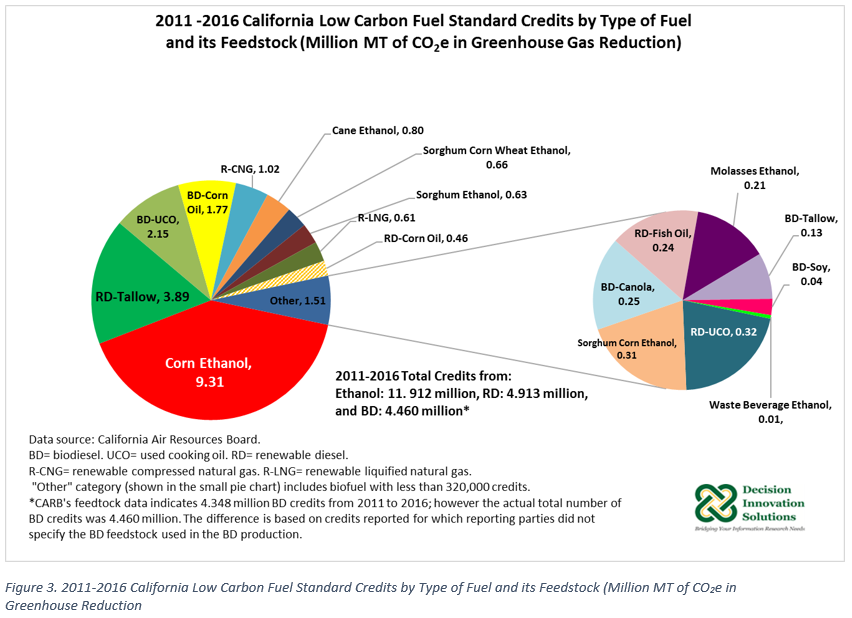The Low Carbon Fuel Standard (LCFS) is a regulatory framework adopted by California to reduce greenhouse gas (GHG) emissions in the state. The program encourages the use and production of a variety of low-carbon and renewable alternatives such ethanol, biodiesel and renewable diesel, which contribute to the reduction of greenhouse gas emissions and replace higher carbon petroleum-based fuels. The goal for LCFS is to reduce the carbon intensity (CI) of California’s transportation fuels by at least 10 percent by 2020. CI accounts for the carbon dioxide emissions related to the extraction, processing and distribution (life cycle) of gasoline and diesel and their corresponding substitutes. Hence, alternative fuels with lower carbon intensity, measured in grams of CO2 equivalent per Megajoule of energy (gCO2e/MJ), are deemed as contributing more to reach the goal of the program.
Since the LCFS program requires reductions in the carbon intensity of California’s transportation fuels over time, a declining average CI for the pool of the state’s transportation fuels is employed to reduce GHG emissions. The CI of gasoline and diesel are 100.53 gCO2e/MJ and 102.76 gCO2e/MJ, respectively. The compliance target value for gasoline and fuels used as substitute for gasoline in 2016 was 96.50 gCO2e/MJ. This value is 95.02 gCO2e/MJ in 2017. In the case of diesel and fuels used as substitute for diesel, the compliance target value in 2016 was 99.97 gCO2e/MJ. This value is 98.44 gCO2e/MJ in 2017. The LFCS compliance schedule for 2011 to 2020 for gasoline, diesel and other fuels used as a substitute for these two fuels can be found here.
Credit Generation
A fuel generates credits if the fuel’s CI level is below the mandated average CI. In contrast, a fuel generates deficits if the fuel’s CI level exceeds the mandated average CI, in which case deficits must be balanced with credits generated by lower CI fuels. The quantity of credits/deficits generated by each fuel is in direct relation to the fuel’s CI level relative to the annual decreasing mandated average CI, and how much of the fuel is used for transportation in California.
On May 12, 2017, the California Air Resources Board (CARB) released the 2016 Compliance Report (CARB, 2017a) for the Low Carbon Fuel Standard indicating a 100 percent compliance rate with the regulation during the past year. There were 224 companies reporting under the LCFS programs in 2016. The report indicated there were 9.061 million credits generated in 2016. Fifty-four of those companies reported a total number of 6.760 million deficits from high carbon fuels. The report also indicated all those companies met their 2016 compliance obligation. LCFS 2016 credit average prices ranged from $122/credit in February 2016 (i.e. $122/ MT CO2e in GHG reduction) to $75/credit in August 2016 (CARB, 2017b).
CARB quarterly data indicates 2016 total ethanol credits represented 38.8 percent (3.519 million credits) of all 2016 credits. Overall in 2016, corn ethanol credits made up 86.6 percent (3.048 million credits) of all 2016 ethanol credits and 33.6 percent of total 2016 credits. Current approved pathway CI values for corn ethanol produced in the Midwest (Iowa, Nebraska, Minnesota, and Illinois) range from 85.58 to 59.60 gCO2e/MJ.
Ethanol, biodiesel, and renewable diesel credits combined generated 7.397 million credits in 2016 (see Figure 1), and represented 81.6 percent of all 2016 credits. Renewable diesel and biodiesel shares of 2016 total credit pool were 23.7 percent (2.150 million credits) and 19.1 percent (1.728 million MT), respectively. Renewable diesel (RD) products made from tallow (RD-tallow) and corn oil (RD-CO) generated 15 percent (1.370 million credits) and 5.1 percent (0.464 million credits) of total 2016 credits, respectively. RD-tallow contributed the most to the RD credits pool, with 63.7 percent of all 2016 RD credits. Among biodiesel fuels, biodiesel made from corn oil (BD-CO) and used cooking oil (BD-UCO) generated 10.4 percent (0.943 million credits) and 6.0 percent (0.540 million credits) of 2016 credits, correspondingly. Fifty-five percent of all biodiesel fuels were from BD-CO.

The number of total credits generated in 2016 was up 64 percent compared with 2015 (5.522 million MT) (see Figure 1). The substantial increase in credits generated in 2016 was due mainly to the implementation of an updated model that calculates the GHG emission of fuels (CA-GREET 2.0 model). In the case of ethanol, using the new model the CI of ethanol declined mainly via the reduction in the indirect land use change (ILUC). This indirect component is only added to CI of fuel produced from crops. The CI of ethanol fuels used in 2016 averaged 71 gCO2e/MJ, showing a decline of 10.57 points, on average, compared with 2015 (81.57 gCO2e/MJ).
Despite the lower estimated CI of ethanol, because the CI of renewable diesel (37.4 gCO2e/MJ) and biodiesel (16.7 gCO2e/MJ) are much lower than that of ethanol, these two biofuels require fewer gallons of each fuel to generate credits (see Figure 2). In 2016 as Figure 2 shows, 1,596 million gallons of ethanol were used to generate 3.519 million credits (452.5 gallons/credit, on average). On the other hand, 249.3 million gallons of renewable diesel generated 2.150 million credits (116 gallons/credit, on average) and 149.5 million gallons of biodiesel generated 1.726 credits (86.5 gallons/credit, on average).

As Figure 3 shows, the cumulative number of ethanol credits since 2011 equaled 11.912 million, representing 46.4 percent of all credits during the six-year period (25.647 million credits). Corn ethanol alone made up 36.3 percent (9.308 million credits) of all credits and 78.1 percent of all ethanol credits during that period. This aggregated data indicates ethanol has been the number one credit-generator fuel in the LCFS program. In addition, renewable diesel and biodiesel generated 19.2 percent (4.913 million credits) and 17.4 percent (4.460 million credits) of all credits from 2011 to 2016, respectively.
The number of ethanol gallons going into the California market from 2011 to 2016 equaled 8.630 billion gallons, with 7.627 billion gallons of that being corn ethanol. Also, 591.491 million gallons of renewable diesel and 429.553 million gallons of biodiesel have been sold into the California market under the LCFS program since 2011.

As indicated by CARB’s data, there have been 25.647 million credits generated from 2011 to 2016 compared with 15.919 deficits over the same period. This indicates the LCFS program has over complied with 9.728 million metric tons of green-gas emission reduction, with ethanol as the largest contributor to the success of the LCFS program. Since LCFS is a state program, it remains in force with no impact from the recent announcement of the U.S. withdrawal from the Paris Climate Agreement.
Sources
California Air Resources Board (2017a), 2016 LCFS Compliance Information and Credit Clearance Market Information.
———, b, Monthly LCFS Credit Transfer Activity Reports.
** This article was originally published in the AgMRC Renewable Energy Report which can be found here: http://www.agmrc.org/renewable-energy/renewable-energy-climate-change-report/renewable-energy-climate-change-report/june-2017-report/ethanol-leads-credit-generation-for-california-low-carbon-fuel-standard/

